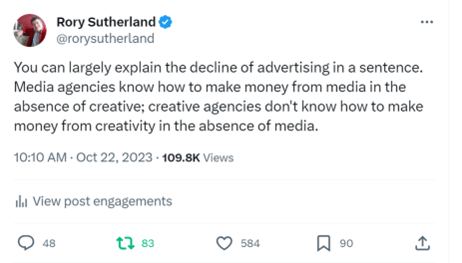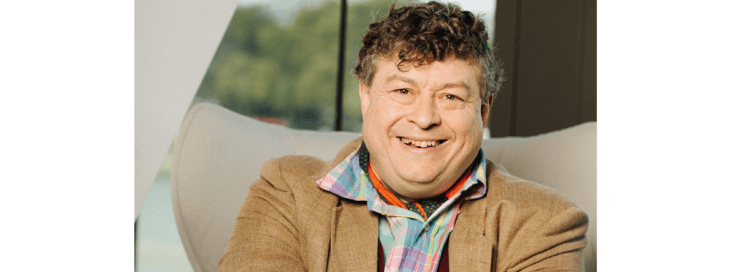Rory Sutherland is Vice Chairman at Ogilvy, as well as an author and marketing expert.
I recently posted this on Twitter, where it has now received over 900 likes in less than a day. This of course is not a measure of the quality of the thought, only of its resonance.
Nevertheless, what I think this suggestion does hint at, however, is a kind of asymmetry that has emerged in marketing communications since media agencies were hived off from creative agencies in the 1990s, a separation which coincided with the end of media commission as the prevalent form of remuneration.
To that extent, this question may seem primarily of interest to people in agencies. But I think it also has a significant bearing on marketing as a discipline, and also at a wider level will affect how consumers relate to business – and even to consumer capitalism as a whole. Let me explain.
There are things I call Sudoku problems. These are problems which can only be solved by an understanding of the complex whole and not by separate optimisation of the constituent parts. I call them Sudoku problems because, like a Sudoku, you can only solve them by contemplating the grid in its entirety, not by cutting the grid into nine separate squares and handing each one to a separate specialism to solve. You could try doing that but, once you reassembled the grid, it would be a mess. You will have three 4s in one column and no 3s in several rows and so forth. Such problems are not merely complicated, they are complex.
Media and creative are effectively in a Sudoku relationship. You cannot separate what you say from where and when you say it. The targeting and the message are interdependent. Moreover a product and its advertising are also in a Sudoku relationship. You cannot research a product in isolation: whether it sells or not will depend not only on what it is and what it costs but also on how you frame and present it and to whom. This explains why the greatest “inventors” – from James Watt to Thomas Edison to Henry Ford to Steve Jobs were also brilliant marketers. It also explains why products such as Santander’s 1-2-3 proposition are so disproportionately effective: they were designed to appeal to humans rather than to bankers. We humans often prefer clarity to optimality.
With a full service agency, many such issues were tackled in parallel. If you bought media, it came with a side-helping of research, consumer insight and creativity. The client, the media agency and the creative agency had an opportunity to refine each other’s thinking to arrive at a coherent whole.
What has now happened is that the media industrial complex – in which I include media agencies and platform owners – has been allowed to disappear down a highly lucrative (and far from transparent) algorithmic rathole, leaving the creative part of the mix effectively surviving off tips.
It is always more profitable – at least in the short term – to turn human judgement into an algorithm, and more profitable still to turn an algorithm into code. The media part of the business has successfully done that. But it has also made itself even more profitable by no longer funding the research and creation of intelligently persuasive content based on deeply potent human insight. The snake-oil used to justify this thievery is the mantra that you don’t need human insight or creativity if you have enough data.
It’s baloney. There will always be a sizeable component of any marketing activity which rests on human judgement. Yet such is the business obsession with automation and quantification, the exercise of that intuitive and empathetic human judgement is being squeezed into extinction.
This has a bearing not only on agencies but also on the wider marketing world. Because this highly lucrative lie not only reduces funding for the costly content-creation component of advertising; worse still it also no longer funds the process that once preceded the creation of an ad. This involved a lot of humans in agencies, research companies and client marketing departments debating what the ad should say. Yet in many ways, this laborious and often painful process may have been even more valuable than the act of running the ad itself. Jeremy Bullmore certainly thought so.
For instance, even if you have no media budget at all, it may be perfectly worthwhile to create an ad campaign for your product just for the value of imagining and refining how you present it – even if the ad you generate never runs.
But try getting a budget for that. It’s easy to get a budget for creative-free media; it’s almost impossible to get funding for media-free creativity. This does not only come at the expense of brand-building ads, it also comes with something much worse – a massive loss of insight. Without going through the old ad creation process, it might never have occurred to Audi that they needed to be more explicitly German. Without this process, no one would have suggested that Dove need not follow the category rules for beauty products, or that the late Bernard Matthews should front his own ads. Yet all three of these differentiating insights hugely multiplied the value of every pound spent on media.
But, at the aggregate level, as I mentioned above, I worry even more. I am sure that the targeting of digital ads is somehow informed by data, but the content of digital ads is entirely lacking in empathy. It is entirely transactional. When did an online ad last make you smile, laugh, wince or cry? The notion of a relationship with the consumer based on a mutual understanding and a recognition of our shared humanity has been lost entirely. I’m sure this is a great way of saving money to meet your quarterly forecast, but the wider cost in lost likeability and trust is many times greater.
INTERVIEW: Why adverts have got less ‘charming’ – and what to do about it

